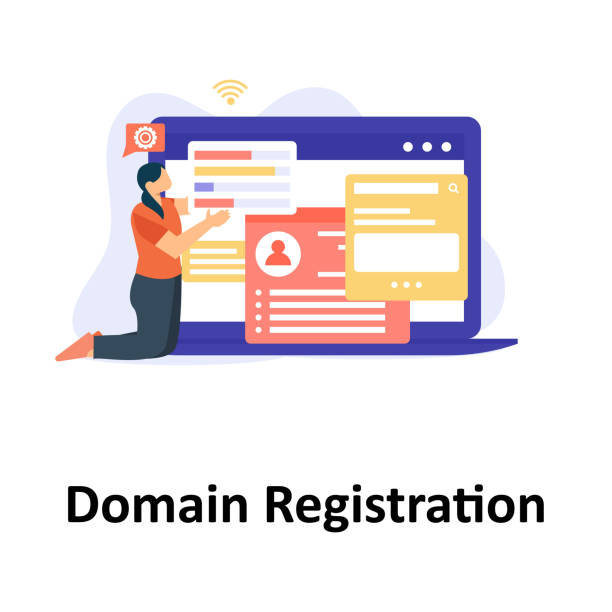An Introduction to Responsive Web Design: Its Concept and Necessity

In today’s digital world, where various devices with different screen dimensions are available to users, the concept of #Responsive Web Design has gained more importance than ever.
It’s no longer enough to just have a website; your website must provide a seamless and flawless user experience on any platform.
#Responsive_Design (Responsive Web Design) is an approach that enables websites to automatically adapt their design and layout to the user’s screen size, whether it’s a small smartphone, a tablet, a laptop, or a wide desktop monitor.
This adaptability includes not only font and image sizes but also the arrangement of elements, menus, and even interactive functionalities.
The importance of this approach is such that many search engines, like Google, prefer responsive websites in their rankings.
This evolution signifies a paradigm shift from desktop-first design to Mobile-First Design, as a significant portion of web traffic today comes from mobile devices.
Therefore, #responsiveness is not a luxury choice, but a necessity for any online business or organization looking to retain and increase its audience.
This educational approach helps you gain a deeper understanding of the foundations of this vital technology.
Do you have an e-commerce site but your sales aren’t as you expect? RasaWeb solves your problem forever with professional e-commerce website design!
✅ Significant increase in conversion rates and sales
✅ Unparalleled user experience for your customers
⚡ Click to get free consultation with RasaWeb!
Key Principles of Responsive Web Design in Practice

Responsive web design is built upon three fundamental principles that every developer must master: Fluid Grids, Flexible Images, and Media Queries.
Fluid grids use relative units like percentages to define the width and height of elements, instead of fixed pixel units.
This approach ensures that the website layout changes fluidly and proportionally with the screen dimensions.
Flexible images, by using properties like `max-width: 100%` in CSS, ensure that images never overflow their container and scale up or down proportionally with the available space, without losing their visual quality.
This specialized content is crucial for web designers.
But the most important element among these is media queries.
Media queries are CSS rules that allow the browser to apply different styles based on device characteristics such as screen width, height, orientation (landscape or portrait), and even resolution.
For example, you can define that on screens with a width less than 768 pixels, the navigation menu should appear as a hamburger menu, or content columns should stack vertically instead of side-by-side.
This capability provides precise control over the user experience across different devices.
These principles work together to enable a website to dynamically adapt to any environment, eliminating the need to develop separate versions for each device.
Benefits of Responsive Web Design for Businesses and Users

Responsive web design goes beyond a mere technical approach; it is a powerful strategy that brings countless benefits to businesses and users.
One of the most prominent benefits is improved user experience (UX).
A website that displays well and is easy to navigate on any device keeps users satisfied and increases their likelihood of returning.
This, in turn, leads to a reduced bounce rate and increased user time on the site.
Another advantage is improved SEO.
Google has officially stated that it gives higher rankings to responsive websites in its mobile search results, because a single URL for all devices means easier content management and avoids duplicate content.
This is a great analytical advantage that helps with search engine optimization.
Economically, developing and maintaining a responsive website is usually cheaper than developing and maintaining multiple separate versions (e.g., a desktop version and a mobile version), as it has a single codebase and changes are applied in one place.
This significantly helps reduce development costs and increase efficiency.
Furthermore, responsive websites are future-proof due to their high compatibility and maintain their functionality with the emergence of newer devices.
Here is a table of the key benefits of responsive design for businesses and users:
| Benefit for Business | Benefit for User |
|---|---|
| Improved SEO ranking and organic traffic | Seamless and optimized user experience across all devices |
| Reduced development and maintenance costs | Easier and faster access to content |
| Increased conversion rates and sales | Reduced need for zooming or horizontal scrolling |
| Future-proofing and compatibility with new devices | Increased satisfaction and brand loyalty |
Challenges and Misconceptions in Implementing Responsive Design

Despite all the advantages that responsive web design offers, its implementation is not without challenges and is sometimes accompanied by misconceptions.
One of the main challenges is the complexity of designing for a large number of devices with different dimensions.
Designers must carefully identify breakpoints where layout changes are needed, and this requires extensive testing and iteration.
A common misconception is that “a responsive website only changes the layout”.
While responsiveness goes beyond visual changes and also includes performance optimization (such as loading appropriately sized images for mobile devices) and user experience (such as simplifying navigation for small screens).
Another challenge is performance concerns.
If responsive web design is not implemented correctly, it may lead to slower website loading on mobile devices, as the browser might have to download all resources (high-resolution images, fonts, etc.), even if they are not necessary for display on that specific device.
This thought-provoking content points to the importance of meticulous planning.
Also, some assume that being responsive means removing content on smaller devices, while the main goal is to provide complete content with an optimized layout.
Content management on a responsive website can also have complexities, as content must be designed to be readable and understandable across all sizes.
Overcoming these challenges requires deep knowledge, meticulous planning, and the use of appropriate tools to fully leverage the potential of responsive design.
Did you know that 85% of customers check your company’s website before any interaction?
With RasaWeb, build a corporate website worthy of your credibility.
✅ Increased credibility and customer trust
✅ Attracting high-quality leads
⚡ Get free website design consultation
Powerful Tools and Frameworks in Responsive Web Design
![]()
To facilitate the process of responsive web design, numerous tools and frameworks have been developed that help designers and developers quickly and efficiently create responsive websites.
One of the most popular and widely used frameworks is Bootstrap.
Bootstrap is an HTML, CSS, and JavaScript framework that provides a set of predefined user interface components (such as menus, forms, buttons) and a responsive grid system.
This framework helps accelerate the development process and ensures your website displays well on all devices.
Another simple and lightweight framework is Foundation, which provides high flexibility for more complex projects.
In addition to complete frameworks, new CSS techniques like Flexbox and CSS Grid have revolutionized responsive web design.
Flexbox is very suitable for arranging elements in one dimension (row or column) and easily allows for alignment, space distribution, and reordering of elements.
CSS Grid, in contrast, is designed for arranging elements in two dimensions (rows and columns) and allows designers to create complex layouts and advanced grids with precise control over element placement.
These specialized tools enable developers to not only build a responsive website but also design a website with excellent performance and optimized user experience.
Using these tools makes the development process much more efficient and enables the creation of complex layouts.
User Experience (UX) in Responsive Web Design: Important Considerations

User Experience (UX) plays a pivotal role in the success of any website, and in responsive web design, this importance is twofold.
A responsive website must not only be visually adaptable across different devices but also effectively respond to the needs and expectations of users on any platform.
This includes aspects like intuitive navigation; meaning users should be able to easily move around the website, whether using touch gestures on mobile or a mouse on desktop.
Appropriate sizing of clickable or touchable elements (like buttons and links) is also very important, especially on touch devices where users interact with their fingers.
Furthermore, optimizing content for different devices means adjusting how text, images, and videos are displayed to be readable and engaging on any screen size.
This guiding and analytical content helps designers have a more comprehensive view.
For example, on mobile devices, content might need to be displayed more concisely and with clearer headings to prevent excessive scrolling.
Page Load Speed is also a critical component of UX.
Mobile users are very sensitive to website speed, and slow websites can quickly lead to user abandonment.
Therefore, using optimized images, clean coding, and caching techniques is essential in responsive web design.
The ultimate goal is to provide a smooth, enjoyable, and efficient user experience that encourages users to stay and interact more with the website, regardless of the device they are using.
Performance Optimization in Responsive Websites

One of the most important aspects of responsive web design that is often overlooked is performance optimization.
If a responsive website is not optimized, it can perform slowly on mobile devices and lead to a poor user experience.
Images are one of the biggest factors contributing to slow loading speeds.
To counter this, techniques such as “Responsive Images” should be used, which allow the browser to load the appropriate image based on the screen size and device resolution.
This can be done using the `srcset` and `sizes` attributes in the `` tag or the `
This specialized content is essential for every developer.
Compressing and optimizing CSS and JavaScript files is also crucial for reducing load times.
These files should be minified (extra characters like spaces and comments removed) and sent to the browser compressed (gzip) as much as possible.
Lazy Loading for images and videos can also significantly improve initial page load speed, as content is only loaded when the user scrolls to it and sees it.
This is a key tip for increasing website speed.
Additionally, using Content Delivery Networks (CDNs) for hosting static files and leveraging browser caching also significantly helps improve performance.
All these techniques together help increase the speed and efficiency of responsive web design and ensure that users, regardless of their device, have a fast and smooth experience.
Below is a table of performance optimization methods in responsive websites:
| Optimization Method | Brief Explanation |
|---|---|
| Responsive Images | Providing images with different sizes and resolutions based on the user’s device |
| CSS and JavaScript Compression | Reducing the size of CSS and JS files by removing extra characters |
| Lazy Loading | Loading content (images, videos) only when they come into the user’s viewport |
| Using CDN | Distributing static content on servers closer to users to increase speed |
| Browser Caching | Storing static files in the user’s browser for subsequent visits |
The Future of Responsive Web Design and Adaptation to New Devices

The future of responsive web design is evolving at an relentless pace, and with the emergence of new devices and advanced technologies, this approach must also adapt.
Beyond smartphones and tablets, today we are seeing devices like smartwatches, foldable displays, virtual reality (VR), and augmented reality (AR), each creating new challenges and opportunities for web designers.
This analytical news content explores the future of this industry.
Adaptive Design, a subset of responsiveness, may play a more prominent role in the future, meaning that the website provides specific layout versions for certain categories of devices, rather than changing in a fully fluid manner.
This approach is particularly useful for devices with vastly different characteristics.
Also, designing for Dark Mode and increasing attention to reducing energy consumption on websites are future trends that responsive web design should consider.
With the advancement of Artificial Intelligence and Machine Learning, we may see the emergence of tools that automatically optimize responsive layouts based on user behavior and device type.
The concept of Progressive Web Apps (PWAs), which offer a combination of the best features of web and native applications, will also become increasingly intertwined with responsiveness.
These developments show that the core principle of responsive web design – adaptability and flexibility – will remain relevant and essential for a long time, even in the face of a rapidly changing digital ecosystem.
Does your current corporate website not reflect your brand’s credibility and power as it should? RasaWeb solves this challenge for you with professional corporate website design.
✅ Increased credibility and visitor trust
✅ Targeted attraction of more customers
⚡ Click to get free consultation!
Case Studies and Successful Examples of Responsive Web Design

To better understand the power and effectiveness of responsive web design, looking at successful real-world examples can be very insightful.
Many large companies and reputable global media outlets have designed their websites responsively to ensure that their audience has the best experience, regardless of the device they use.
For instance, The Boston Globe‘s website was one of the pioneers in this field, demonstrating in the early 2010s with a fully responsive design how a news site can function well across various screen dimensions and deliver content optimally.
This entertaining and educational content provides you with design ideas.
Websites like Airbnb and Netflix are also excellent examples of responsive design, offering an unparalleled user experience on mobile devices, tablets, and desktops with fluid layouts and image optimization.
Even large e-commerce websites like Amazon, although they have dedicated mobile versions, have also incorporated responsive elements into their design to increase compatibility and accessibility.
These examples demonstrate that responsive web design is not only implementable for simple websites but is also highly effective for complex platforms with a large volume of content and user interactions.
Studying these cases helps us identify Best Practices and apply them in our own projects, and understand how to design a website that is both aesthetically pleasing and performs excellently on any device.
Conclusion and a Step Towards an Inclusive Web with Responsive Design

In conclusion, it can be stated that responsive web design is no longer merely a trend, but has become a fundamental standard for modern web development.
Given the ever-increasing variety of devices users employ to access the internet, a website’s ability to automatically adapt to any environment is crucial.
This approach not only improves user experience and increases customer satisfaction but also directly impacts SEO ranking, conversion rates, and ultimately, the success of an online business.
The challenges inherent in implementing responsiveness are solvable and manageable with the powerful tools and frameworks available, and its benefits far outweigh these challenges.
By considering key principles such as fluid grids, flexible images, and media queries, along with attention to performance optimization and user experience, websites can be built that are not only aesthetically pleasing but also highly efficient and future-proof.
This is a comprehensive explanatory and guiding content for anyone looking to build a successful online presence.
Responsive web design is, in essence, a step towards building a more inclusive and accessible web for everyone, regardless of their device type or abilities.
Now is the time for all designers and developers to place this approach at the core of their design philosophy to ensure their websites remain relevant and effective in the ever-changing digital world.
Frequently Asked Questions
| Question | Answer |
|---|---|
| What is responsive web design? | A method in web design that automatically adjusts and optimizes the layout and content of a website for different devices (mobile, tablet, desktop). |
| Why is responsive design important? | Due to the variety of devices users employ to access the web; better user experience, stronger SEO, and reduced bounce rate are among its benefits. |
| What are the main techniques in responsive design? | Using Media Queries in CSS, Fluid Grids, and Flexible Images. |
| What is a Media Query? | A CSS rule that allows you to apply different styles based on device characteristics (such as screen width, height, display orientation). |
| Is responsive design different from Mobile-First design? | Mobile-First is an approach within responsive design that initially designs the site for the smallest screen (mobile) and then progressively enhances it for larger screens. |
And other advertising services of RasaWeb Digital Marketing Agency
Smart Conversion Rate Optimization: A specialized service for growth in customer acquisition based on user experience customization.
Smart Link Building: A professional solution for digital branding with a focus on precise audience targeting.
Smart Marketplace: A professional solution for attracting customers with a focus on precise audience targeting.
Smart Marketplace: A fast and efficient solution for campaign management with a focus on marketing automation.
Smart Digital Advertising: A combination of creativity and technology to increase click-through rate through Google Ads management.
And over hundreds of other services in the field of internet advertising, advertising consultation, and organizational solutions
Internet Advertising | Advertising Strategy | Advertorial
Sources
Responsive Web Design and the Future of WebPrinciples of Responsive Design for Modern WebIntroduction to Responsive WordPress ThemesBenefits of Responsive Website Design
? Are you ready for your business to leap forward in the digital world? RasaWeb Digital Marketing Agency, by providing comprehensive and specialized services, paves your way for growth and visibility. From SEO-optimized website design and search engine optimization to social media management and targeted advertising, we are by your side to help you have a powerful and effective online presence.
📍 Tehran, Mirdamad Street, next to Central Bank, Southern Kazeroun Alley, Ramin Alley, No. 6



